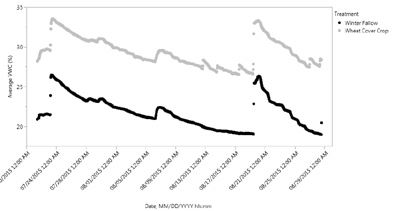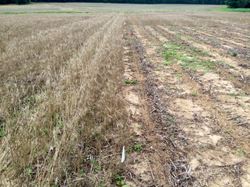Increasing Water Use Efficiency/Drought Tolerance And Yields With Cover Crops
DR. TYSON RAPER
JACKSON, TENN.
Increased infiltration rates, increased soil water retention, and decreased rates of erosion are frequently mentioned as benefits of integrating a cover crop into a production system. In order to test these proposed benefits, a site was selected early in 2015 to compare a wheat cover crop versus fallow managementin an irrigated environment. The selected site was relatively steep hillside (soil was a Providence silt loam and ranged from 4-6 percent slopes) under a pivot irrigation unit at the Milan Research and Education Center in Milan, Tenn. Immediately after the site was selected, four replications of wheat cover crop and winter fallow treatments were established. An image of a fallow and wheat cover crop treatment can be seen below. Wheat cover crop treatments were terminated roughly two weeks before planting. After emergence, soil moisture sensors were placed at multiple depths (3, 9, 18 and 30″) in multiple replications of both treatments.
So what was the outcome?
One period of water stress was noted at the end of the effective flowering period (Mid-August). During this period, average observed soil moisture measured by the sensors was notably greater in plots with a wheat cover crop (see graph). Additionally, shallow sensors in plots with wheat cover crops were more likely to respond to an irrigation event or rainfall event than shallow sensors in the fallow treatments. This is also evident by examining the sensor averages across multiple replications over time. The increase responsiveness is pictured by the three spikes evident between August 13th and August 20th.
Most notably, the wheat cover crop treatment increased lint yields. Consistent, significant yield increases were observed across replications. Plots with wheat cover crops averaged 111 lb lint more per acre than winter fallow treatments. Although it is unlikely that this response can be fully attributed to the increase in soil moisture, it does appear that an increase in available soil moisture associated with the wheat cover crop treatment did contribute to the observed increase in lint yields.
Take Home:
• Soil moisture measurements suggest the wheat cover crop increased infiltration and soil water retention.
• Impacts were consistent throughout the season- even after the above-ground residue had begun to break down.
• Benefits associated with incorporating a cover crop are not only limited to irrigated acres; cover crops could increase infiltration and soil water retention on dryland sideslopes, thereby increasing drought tolerance.
• This limited dataset suggests that cover crops may have the ability to prevent yield penalties in periods of slight to moderate deficits.
This work was funded by Cotton Incorporated Project Number 15-862: Mid-south irrigation technology demonstration in Tennessee. Special thanks for their continued support. ∆
DR. TYSON RAPER: Cotton & Small Grains Specialist, University of Tennessee

